Clark Air Base
HISTORY AND SIGNIFICANT EVENTS
©2001 Tim Vasquez
 |
Much of this wouldn't have been possible without the detailed Annotated Pictorial History of Clark Air Base (1899-1986) by David L. Rosmer. I highly recommend it to researchers and historians. Credit also goes out to Lauren Sobkoviak, Mike Ward, Beau E Gros, and numerous sources in print and on the Internet, which unfortunately are too many and sometimes too obscure to list here. |
Clark gets its name from Maj. Harold M. Clark, of the U.S. Army Signal Corps. Born in Minnesota and raised in Manila, he was the first American to fly in Hawaii. Clark died on May 2, 1919 in a seaplane crash in Panama and is now buried in the Arlington National Cemetery. Fort Stotsenberg gets its name from Col. John M. Stotsenberg who died April 23, 1899 in a battle in Bulacan province, and is also buried in Arlington National Cemetery.
1898
Spain cedes the Philippines to the U.S. in the
Treaty of Paris for $20 million. Philippine revolutionaries
turn their hostilities onto American colonial forces.
1899
On February 6 the U.S. Senate voted to annex the
Phillipines.
Americans fought fragmented Philippine forces
in the Battle of Angeles, which began on August 13.
This led to their permanent presence in the Talizundoc area of
Angeles City (what is now the Lourdes Sur barangay), in order
to establish control over the central plains of Luzon.
Hostilities generally ended November 5.
1902
The U.S. Army studies relocating their post from Angeles
City to a fertile plain on what was later Clark Air Base, which
supposedly had better grass for their horses.
1903
President Roosevelt signs an executive order on
September 1
establishing 7700 acres as Fort Stotsenberg, with Camp Wallace and Camp
John Hay being established in November. Fort Stotsenberg was centered on
what was Clark's parade ground in modern years.
1906
The first flagpost at Fort Stotsenberg is commissioned
on September 16 near the modern 13 AF headquarters.
1908
An executive order expands Fort Stotsenberg from
7700 to 156,204 acres, covering much of modern-day Clark and the
mountainous region to the north.
1912
In March Lieutenant Frank Lahm heads the
Philippine Air School on Fort Stotsenberg with one aircraft.
The first concrete buildings (the modern 13 AF headquarters) and
a gymnasium are built.
1917
Five aircraft hangars are constructed at what was the
motorpool in modern times.
1918
The first dependent school, Leonard Wood School, is opened
at Clark.
1919
Construction of a small runway began along what in modern
times was Dyess Highway as it passed by the flightline.
The airfield was officially designated Clark Field.
Three additional hangars were built.
In September
a series of tent dormitories was built, and in November
the 3rd Aero Squadron was formed, giving rise to the popular "3"
that would tag many organizations at Clark in later years (3 TFW, etc).
The first plane to arrive was a DeHavilland DH-4.
1920
The first permanent enlisted dormitory is built.
1925
The second dependent school, Worchester School,
is opened on November 8.
1941
The Japanese launch an attack on Clark Air Base
on December 8, destroying dozens of aircraft.
Clark was evacuated on December 24.
1942
On April 9 American forces fell on Bataan
and Corregidor,
leading a few days later to the brutal Bataan Death March from Bataan to
San Fernando (about 20 miles southeast of Clark).
Japanese forces maintain possession of Clark Field.
1944
American forces begin air raids on Japanese
occupation at Clark in October, continuing for four months
and damaging over 1500 Japanese planes.
1945
On January 31, American forces regained possession of
Clark Field after three years of Japanese control. However a few
Japanese soldiers still held tough in the nearby mountains, and
sometimes sneaked onto base at night to sabotage American planes.
1946
The 13th Air Force is transferred to Clark
in January, except for a brief period between
May 1946 and August 1947 when it was at
Fort William McKinley on Luzon. The Philippines was
given independence on July 4.
Major improvements were underway, including a new chapel, golf course,
the NCO (Top 3) Club, and more.
1947
The U.S. and Philippines sign the Military
Bases Agreement on March 14 which guaranteed American
possession of U.S. bases in the Philippines for 99 years.
The Clark Field Dependents School was opened
July 7.
1948
On April 15 the first Philippine president,
Manuel A. Roxas, died of a heart attack after speaking at the
old Kelly Theater.
1949
In May the facilities at Fort Stotsenberg and Clark Field
were transferred to the U.S. Air Force, and from then on the entire
base became known as Clark Air Base.
The Air Force decided to consolidate all its cemeteries, including
the one on the modern day golf course, and moved them
to the current location near the main gate.
The Silver Wing was built this year.
1950
The first school, [Original] Wurtsmith School
is opened in August in Bldg 3100 near what was the modern
day 1961 CG compound (near Auto Sales).
1951
On August 30 the U.S.-Philippine Mutual Defense Treaty is signed,
which still remains in effect today.
1953
The new Kelly Theater was opened.
1954
The Airmen's Club (Lower 4 Club, or Coconut Grove) was opened,
as well as the new post office near the present-day BX.
1955
A brush fire on Lily Hill reveals the remains
of two Japanese planes.
The Bamboo Bowl stadium is built, while the old chapel in the
hospital area is torn down in May.
1956
U.S. Vice President Nixon visits the Philippines, and formally
acknowledges Philippine sovereignty over American bases in the country.
However the U.S. continued to retain control for nearly 23 more years.
1960
Construction began on the new Regional Medical Center and was
opened four years later.
1961
In April Wagner High School is opened.
1964
Clark entered the Vietnam War effort in March as KC-135
tankers staged from Clark and refuelled fighters enroute to Laos.
On May 11, a C-135B (serial 61-0332 of the 1501 ATW, 44 ATS,
Travis AFB) carrying an Air Force band from Hawaii crashed in
heavy rain 1500 ft short of Clark's runway 02,
killing 79 (including 1 American on the ground in a taxi).
The 200-bed Regional Medical Center was opened April, costing
only $4.5 million.
1966
The large 6-story Chambers Hall building, containing over 300 rooms for
bachelor and transient officers, was opened.
The Rusk-Ramos agreement signed on
September 16 revised the 1947 Military Bases Agreement to
expire in 25 years: 1991, an ominous coincidence.
1967
In August Grissom Elementary School is
opened (known as Wurtsmith Hill School until Nov 14 1968).
1968
Late-night attacks against American servicemen led to
both Clark and Angeles being placed on curfew in August.
Demonstrations flared to a boiling point on October 4.
The new Base Operations building was opened.
1970
Wurtsmith Elementary School is opened in
August, eventually being the home of over 1100 students
at any given time.
1971
Filipino employees went on strike March 3 for the first
time. The walkout lasted three days, and another strike followed
on July 25, this time lasting 15 days. This was at a time when
anti-American sentiment was at a peak.
1972
President Ferdinand Marcos declared martial law, which also
acted to suspend elections. Martial law remained in place until 1981.
Clark's first C-9A aircraft arrived in February.
Lily Hill Middle School was opened
September 18.
1973
The first group of Vietnam POWs arrives
February 12, with a second group following on
February 18.
1974
MacArthur Elementary School is opened in August.
On November 28 Typhoon Irma (not to be confused with the 1981
storm of the same name) hit, with winds at Clark clocked at 83 kt
(95 mph) out of the northwest at 1 pm, and a pressure measured at
979 mb (28.91") at 3 pm. This was the strongest typhoon to
hit Clark.
1975
Clark serves as a staging point for Vietnamese
fleeing the North Vietnamese invasion.
The first planeload, consisting of orphans, arrived April 5.
As many as 2,000 refugees
at a time were housed in a tent city in the Bamboo Bowl during
April and May. A total of 30,082 refugees and
1565 orphans were processed through Clark.
1977
On the evening of May 21 at 1:35 am, a mild magnitude
5.7 earthquake hit just northeast of Clark and was felt by many.
1978
Typhoon Rita hit Clark during the wee hours of October 27,
bringing 58 kt (67 mph) winds but causing little damage.
On December 25 hundreds of politicians rallied against
Marcos in a carefully-written statement seeking to remove American
military presence from the Philippines.
1979
A revised 1947 Military Bases Agreement was ratified on January 7
and executed at Clark Air Base February 16 to transfer command
and security of
Clark and other American bases to the Philippine government. The
size of the Clark reservation was reduced from 156,204 acres to
131,000 acres, with the base itself remaining at 9155 acres.
On March 25, Clark's third major labor strike occurred.
1980
On March 31 a magnitude 6.3 earthquake hit about 80 miles northeast
of Clark at 8:41 pm, but was distinctly felt at the base.
In October Flying Tigers established the first scheduled 747
contract service to/from Clark, replacing Flying Tigers and Trans
International DC-8 service. This
continued for about a decade until Hawaiian Air L-1011's got the contract.
1981
On January 17 President Marcos "removed" martial law,
though this had little effect as his political opponents still
remained in exile.
Later in the year, FEN television switched channels from 8 to 17 (?).
Construction began late in the year on the new commissary, but it
would be a couple of years before it opened.
On November 24 Typhoon Irma (not to be confused with the
1974 storm of the same name) struck, bringing wind gusts to 50 mph
at Clark and causing minor damage (mostly downed tree limbs).
1983
On August 21, Ninoy Aquino, one of President Marcos'
political opponents, returned from ten years of exile and was shot on
his arrival in Manila, precipitating a gradual collapse of the
Marcos administration and the economy.
The Military Bases Agreement was revised further in 1983.
Starting October 3, unionized Filipino employees went on
strike for four days over pay issues.
On December 31, live television programming from AFRTS new satellite
network began at Clark.
1984
On March 12, the U.S. was permitted to begin flying its
flag at the base cemetery.
On March 29 a new Youth Center was opened inside the original Kelly
Theater.
In April the largest commissary in the Air Force opened between
the Post Office and NCO Open Mess. It was completed at a cost of
$6.2 million.
In June the Original Wurtsmith School (not the new one) was
demolished.
In October am HH-53C helicopter crashed in heavy rain during a
nighttime training exercise near the base, killing all occupants.
1985
In March the new Family Support Center opened.
On the evening of April 23 a magnitude 6.3 earthquake hit
just northeast of Clark at 12:15 am.
The opening of the new Golf Club House occurred in August on top
of what was once the old Fort Stotsenberg cemetery.
1986
On January 1 the longtime NCO (Top Hat or Top 3) Club
near its Lily Hill location
moved to a new location near the Silver Wing.
On February 25 after massive outcry over a rigged election,
President Marcos is forced out of office. Helicopters from Clark's
31 ARRS pick him up at his Presidential palace, and flew him to
Clark where he transferred to a C-9A and was flown to Hawaii.
On March 22 at 9 p.m., civilian employees went on strike,
forming large picket lines outside the main gates of all American bases
in the Philippines. Ultimately the strikers blocked Clark's gates on
March 25, preventing anyone from getting on or off base
except those who were resourceful enough to sneak across base
fences. The 3 CSG commander placed Angeles bars off-limits to
servicemen, which pitted strikers against
local merchants. Finally after a scuffle between strikers and
merchants the strike was broken at 4:30 pm on March 30.
On May 31 the longtime Clark AB Officers Open Mess (CABOOM)
was closed for demolition and rebuilding, moving temporarily to the
old NCO (Top Hat) Club.
On September 16 the new nationalist government rejected
extension of the Military Bases Agreement.
On December 29 at 11:49 pm a mild magnitude 6.0 earthquake
struck along the coast west of Clark.
1987
On April 25 at 8:16 pm a strong earthquake, at magnitude 6.5,
hit just north of Clark.
On October 28 three servicemen were killed in simultaneous
attacks near Clark AB
by teams of the New People's Army (NPA) brandishing .45 caliber
pistols. The NPA is the strongarm of the Philippine
communist party.
1988
On the evening of October 25 Typhoon Ruby brought 46 kt
(53 mph) winds to Clark AB and 69 kt (79 mph) winds to Subic Bay,
making it the strongest storm at Clark since Rita in 1978.
1989
On September 26 shortly before Vice President Quayle's
visit to Clark, NPA terrorists killed Ford Aerospace employees
William Thompson and Donald Buchner at a roadblock near Camp O'Donnell.
Terrorist tension reached a climax in December.
1990
Clark's worst earthquake occurred at at 3:26 pm on July 16.
It registered magnitude 7.6 and was centered about 80 miles northeast
of the base. Baguio was devastated, with over 2000 killed and a
million homeless.
1991
In April pilots reported seeing smoke
emanating from Mount Pinatubo, and by June it was clear
that a major volcanic eruption was imminent.
Evacuation of Clark AB began on June 10.
The first "big" eruption hit June 12.
On June 14, the base was drenched in a sea of ash, and
the biggest eruption followed at 5:55 am on June 15
just as Typhoon Yunya was making its approach.
The Philippine Senate rejected an extension of the
Military Bases Agreement, and it expired on
September 16.
The U.S. Air Force formally transferred Clark in its entirety to
the Philippines on November 26, ending its century-long
presence in the region.
1992
The U.S. Navy withdrew the last of its forces from Subic Bay
on October 1.
1993
On April 3 President Fidel Ramos approved the
Clark Special Economic Zone and established the Clark Development
Corporation.
1995
The Clark International Airport Corporation was established to
manage the airfield facilities.
1996
Limited air service from Clark to Hong Kong began.
1997
The last U.S. forces leave the Philippines on November 24.
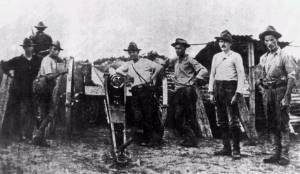
1899: A U.S. Army field artillery unit at its Angeles City post.
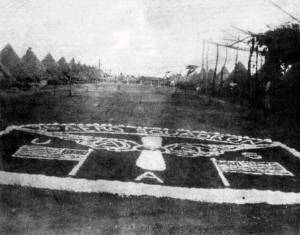
1919: 3 Aero Squadron logo made of rocks and the
"main drag" along the enlisted housing tents.
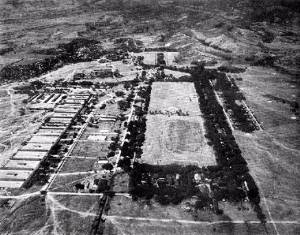
1937: Looking west on Fort Stotsenberg, nestled around
the parade ground.
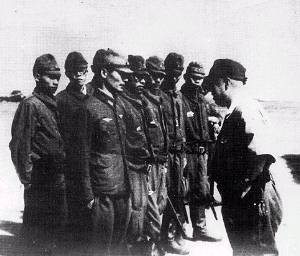
1944: Clark pilots during World War II consisted essentially
of the Japanese Imperial forces. Here Clark's Japanese Air Forces commander
addresses a group of pilots.
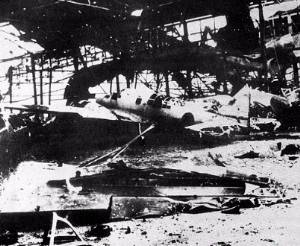
1945: Hangared Japanese planes at Clark began suffering heavily
at the hands of American bomber attacks toward the later years
of WWII.
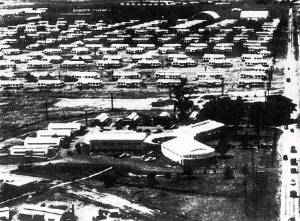
1952: Clark's first major BX was in this star-shaped building.
It became the Arcade while the new modern BX was built in the 1960s.
Looking south along Leary Avenue toward the accompanied airmen
housing area.
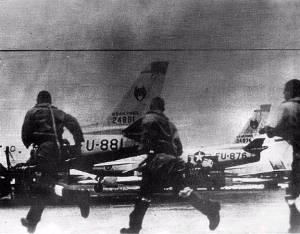
1954: Pilots and ground crew race to their F-86 during a
practice alert at Clark.
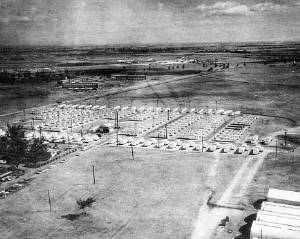
1965: The trailer park near the Silver Wing was established
in the 1960s to house a surge of transient personnel during the
Vietnam War.
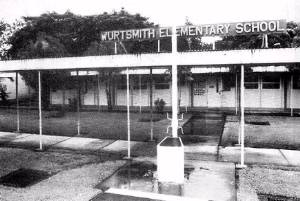
1970: A new elementary school opens in the Hill Housing Area:
the new Wurtsmith Memorial Elementary School.
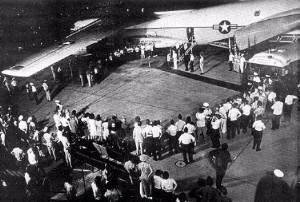
1973: A C-141 arrives at Clark from Hanoi with POWs during Operation
Homecoming.
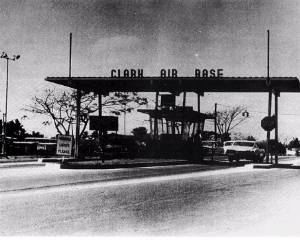
1979: A sight familiar to many -- Clark's main gate at
Angeles City.
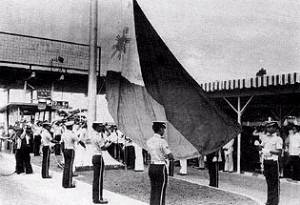
1979: The year 1979 was a pivotal point in Clark's history as
the Philippine government began assuming administration of the base.
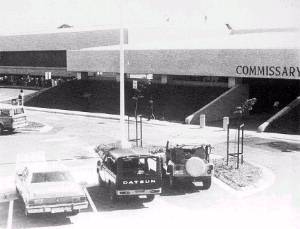
1984: The largest commissary in the Air Force opens at Clark
after over two years of construction plagued with delays.
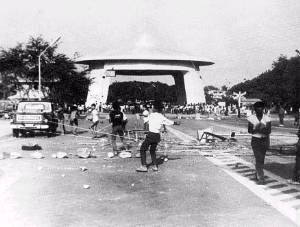
1986: A weeklong strike at Clark's main gate severely crippled
base activities.